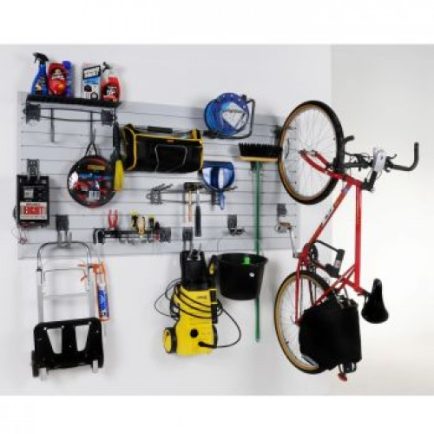Sponsored Post – Wooden Slat Wall
A wood slat wall is made of vertical strips of wood that extend from the floor to the ceiling. It is most often constructed from wood panels that feature horizontal grooves or slats that are capable of accepting various accessories such as bins, hooks, and shelves. Slatwall is available in a variety of forms including free-standing styles, or full wall panels that can be affixed to existing walls. In many cases, a Slatwall system will be reinforced with aluminum inserts that fit into the grooves of the Slatwall. Not only does this aluminum provide added strength and support, when highlighted with color it gives the user the option to customize the look of their Slatwall as desired.
Benefits to Using Slatwall
No matter the way in which you plan to use Slatwall, there are a number of benefits to this system that all will appreciate. For one, aluminum Slatwall is incredibly durable. Despite the fact that it can be loaded with a variety of heavy objects, Slatwall is known to hold up over time. Further, it is very difficult to damage Slatwall, adding to its impressive life expectancy. Another benefit to using Slatwall is that it can be customized in terms of color and design to match the style, décor, or use of space. This is particularly beneficial in retail settings where specific colors are needed to maintain brand image. Finally, Slatwall is very affordable and can be repurposed over and over again for another display and use. With such versatility, you can have a user-friendly, durable, and versatile storage solution for your space.
How does a slat wall work?
Slatwall is a wall paneling material used to display, store, and organize items on your wall. The panels have slots or grooves which are used to hang shelving, hooks, wire baskets and many other accessories. The slatwall installation process will require at least one helper, but two will make the job easier.
What type of wood is used for slat walls?
If you’d like slats that hug the wall closely, you’ll want to use nominal 1/2-inch plywood (about 3/8 inch thick). With dimensional one-by-two lumber, the strips would be 3/4 inch thick.
History of slatwall
In 1964, Harold E. Graham hand-built a prototype for slatwall and filed for US Patent #US3235218A. His idea was to display items efficiently and effectively on a wall without needing a permanent fixture attached to the wall.
Graham had a hard time enforcing his patent because, with superior machinery, larger companies could rapidly reproduce his invention with slight variations (thus, the many names slatwall now has). With the boom in production, slatwall became common in many retail stores through the 1970’s.
Slatwall customization was exploited early on. Different slatwall styles of wood and other materials became new features to regular slatwall. Custom colors, shapes, patterns, and images created enormous possibilities for in-store branding. Plastic and metal inserts were also added to reinforce and strengthen slatwall.
What is slatwall known as?
Over the years, slatwall has been called many different things by its inventor and his competitors – for legal and practical reasons. Slatwall has been known as
● Slotwall
● Slat board
● Bracket board
● Slotboard
● Groove wall
● Grooved wall
● Fixture display board











